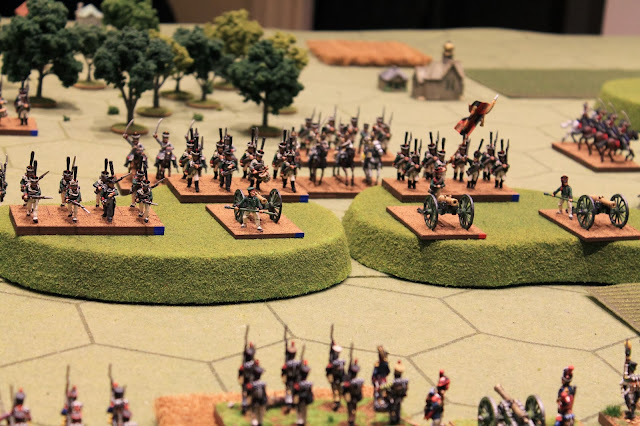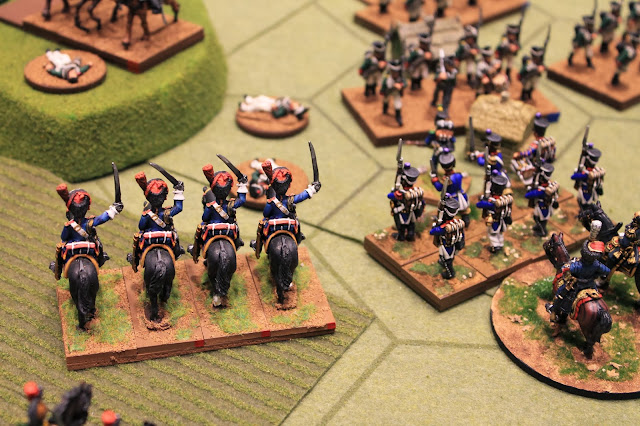Turn 1: 8am
The French and Russians are deployed near each other, but cannot see each other well due to a raging snowstorm. (Imagine the snow blowing fiercely and covering the ground.)
 French troops in front of Eylau. Notice the Brigade of infantry wearing white uniforms. I was very pleased to have some of these to deploy for the battle.
French troops in front of Eylau. Notice the Brigade of infantry wearing white uniforms. I was very pleased to have some of these to deploy for the battle.The Russian Line across the way. Notice the Grand Battery dominating the ridge.
Augereau's Corps deployed south of Eylau.
Russians across from Augereau.
More Russians north of Eylau.
The Emperor with his guard on the hill behind the town.
In order to simulate the confusion on the field due to the snow storm, I gave Paul a unique 'card' to play at any time: He could reposition any two of my infantry units before taking his turn. Naturally he couldn't wait and played it immediately before his first turn. In an ode to history, he moved Augereau's corps right up to the muzzles of his grand battery and opened fire on them.
Both brigades took some losses and fled.
My response was to order Murat and the Cavalry reserve to charge the southern end of the Russian position on the ridge to (hopefully) clear off his artillery.
Six Brigades of Cuirassiers and Dragoons rode forward.
Charge!
Due to the snow the artillery fire wasn't very accurate and the charge succeeded in overrunning some of the guns.
9:00 am The fighting swirled for a couple of turns as the French cavalry pressed their attack home. Here the Carabiniers attack the Russian guns.
...and overrun them, but sustain heavy losses.
Paul felt that he couldn't allow me to take possession of the southern end of the ridge as this would break his line and cut off his left flank deployed to meet Davout's corps, which was arriving on the battlefield to the south. So he played a 'Drive them Back' card...
...and launched a counter-charge with his Cuirassier and Dragoons released from his central reserve.
They not only swept the weakened Carabiniers from the ridge...
...but killed Marshal Murat (sadly I don't have a Murat figure...I need to remedy this). This not only weakened my command control of the large cavalry force in the area, but reduced my over-all command control rating by 1. Not good. Now both armies had a '5' rating.

I was forced to spend a turn regrouping my forces. I drew back the dragoons, moved up a fresh division of Cuirassier, and had Davout ride over to the left of his corps to take command of the cavalry action.
10:00am The Russians bombarded the French near Eylau, and the French launched a renewed attack on the critical hinge of the Russians position in the south. In this picture, Davout directs a brigade of his infantry to assault the village of Serpallen, while the Imperial Guard Heavy Cavalry makes a 'glorious charge' (+2 dice; retreat flags have no effect) on the embattled ridge.
Charge!
The impact of the 'Big Boots' is tremendous! They ride right over the Russian Dragoon brigade, up the ridge into and over the Russian Cuirassier brigade, and on into and over the depleted Russian artillery unit that had just moved back onto the ridge.
Finally coming to a halt in the face of a fresh artillery unit. What a ride!
11:00am Paul, desperate to force the now swarming French cavalry off the ridge sends forward the only troops available: a unit of Russian Musketeers and one of Hussars. The French response is merciless. The musketeers are charged by Cuirassiers and Dragoons, and when they form square are blasted with grapeshot at close range by the French horse artillery. All that remains is a heap of corpses, and the Russian Hussars fall back off the ridge under pressure from the French Dragoons.
Davout's attack from the south starts to make headway, and with the success of the French cavalry on their left, the entire Russian left flank is in danger of being overwhelmed.
The Russian left flank opposite Davout's men as they move up through the forest.
The Russian commander reluctantly decides to pull his men back to retain contact with the main Russian position.
Davout doesn't want to let them get away unscathed, so he decides to keep up the pressure and orders the heavy cavalry to press them. The Russian infantry forms square, but is now pinned and can't continue the withdraw to their new line in the woods.
Unfortunately this aggressive move leaves the French cavalry open to a counter-attack on their exposed right flank by the Russian cavalry.
A Russian Cuirassier and a Hussar brigade charge home and scatter two French Cuirassier brigades.
The Russian cavalry charge removed the immediate threat to the Russian infantry on the Russian left.
More to follow on Monday.




























Looks like a great scenario, Glenn. Your setup is beautiful!
ReplyDeleteThanks Scott!
ReplyDeleteIt truly is beautiful...partly thanks to you. The Russian army turned out wonderfully. They make a great impression on the field.
Looking forward to grassing the bases in the next week or so and to putting on Borodino with them at Little Wars in April.
Fantastic table layout with stunning figures. Your table is clean yet functional. Your BatRep is really quite well done. Thanks for putting it all together for sharing.
ReplyDeleteGreat job!
Thanks Jonathan!
ReplyDeleteI know that you also love some Command & Colors Tabletop gaming.
I developed these Napoleonic rules about six years ago based on C&C: Ancients (Their Napoleonic wasn't published yet).
The rules have evolved quite a bit and work really well. They are still fast play, but have a real feel for the Napoleonic era. Players are rewarded for making good decisions and using the right tactics for each situation. Coordinating Infantry, Cavalry, and Artillery is especially important as each arm has strengths and weaknesses in the system appropriate to the terrain and the circumstances.
I love the card play mechanic as it forces the player to plan their sequence of attacks, and it works as a built-in mechanism for balancing command control and initiative. While most wargame systems allow the players to just move everything and keep attacking, or place artificial or random restrictions on which units are active, this system allows the players to decide which area of the battlefield is activated on that 'impulse' (turn).
I did finally remove the artificial 'left-center-right mechanic featured in C&C because it was just too game-y and didn't allow battles to flow naturally.
I replaced those cards with 'Command' cards which allow the player to activate various numbers of units within the command radius of a general. This adds a very interesting challenge of balancing the need to use generals to lead attacks (for the bonus), and the need to use them as a nexus of command - directing and coordinating the movements of the forces around them.
This means that the player must also try to position them to the best advantage, and then often re-position them as the battle ebbs and flows.
I like that modification from sector to commander.
DeleteSo in the case of this battle, Murat was leading the cavalry attack on the Russian position on the south end of the ridgeline. The attack was succeeding when my opponent counter-charged the unit that Murat was attached to, and eliminated it, leading to a leader casualty check (1 in 6 chance - helmet die face = leader casualty, otherwise the general evades back two hexes).
ReplyDeleteWhen Murat was captured or killed, I not only lost the combat advantage for the unit that he was attached to, I lost his ability to activate units around him. Therefore I couldn't use Command cards to keep the attack rolling forward efficiently until I moved a new general into the vicinity.
With his loss I also lost 1 Command Rating point, which meant that I now only had 5 cards in my hand to choose from, negating one of my advantages over the Russians.